Choosing the right paper stock or coating for your project is important to achieve the desired result.
What is uncoated paper?
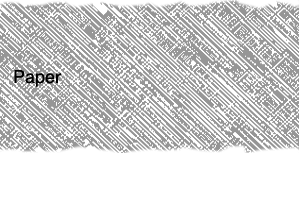
Exaggerated Side View Illustration
|
All paper stocks start out being uncoated. Uncoated paper is porous with an uneven, rougher surface. As a result, uncoated paper is easier to write on as it absorb ink readily and dries to the touch faster. However, the heavier amount of ink uncoated paper absorbs may result in less rub resistance. Uncoated stocks include bonds, offsets, card, and newsprint. |
What is coated paper?
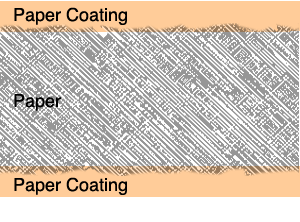
Exaggerated Side View Illustration
|
After manufacture, the uncoated paper surface may be coated with white clay materials. The clay gives the paper a smooth feel by filling minute valleys in the paper surface. The coating also limits the absorption of inks into the paper. Because the inks stay on the surface of the coating instead of soaking in, the ink looks deeper, sharper and glossier. However, writing and ballpoint pen inks may take longer to dry on coated paper and can smudge more easily. On coated stock, less ink is need to achieve the desired visual richness for text, images and photo's.
Coatings are offered in a range of reflectivity values including dull, matte, silk, satin or glossy. Reading long areas of text is easier when printed on dull or matt finishes. After printing images on dull or mat stock, a varnish can be applied to the picture areas to add gloss and make the pictures pop.
|
What's the difference between coated and uncoated paper?
Paper with a coating is smooth and shiny while uncoated paper is flat with little or no shine. Gloss stock makes colors look smoother, deeper, richer, with great color-contrast. Photo's and graphics tend to look better on gloss stock, while text heavy documents and artwork are often use matte stock.
Text is more easily read on paper with a matte finish. The softer looking dull surface of matte paper provides color contrast and clarity. Unlike glossy paper, matte stock is more forgiving of fingerprints, smudges and dust.
Uncoated paper is very absorbant, and ink dots will tend to spread outwards (i.e., dot gain), leading to a less precise and darker image than when printed on coated stock. A similar effect happens when a paper towel is placed on a spilled drop of coffee. The drop diameter increases and gets a ragged edge as the liquid spreads in the absorbant fibers. This dot gain can be minimized using sophisticated printing techniques, but it can't be eliminated. Coated paper is less absorbant and therefore dot gain is usually not an issue.
What's the difference between coated paper and a coating finish?
A coated paper is produced at the paper mill with a smooth surface and can have a range of reflectivity values including dull, matte, silk, satin or glossy. A coating finish on the other hand is a clear layer applied after the ink is printed on the paper. It is used to enhance the visual appeal of printed graphics or to add durability and protection to the printing.
What is uncoated finishing?
A protective coating or varnish will not be applied to the printed piece.
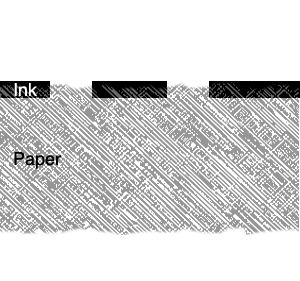 |
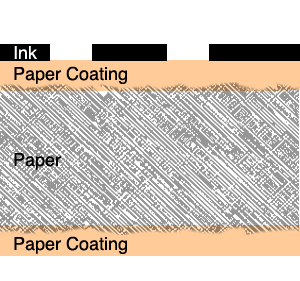 |
|
Exaggerated Side View Illustration
Printed paper, no finishing coat.
|
Exaggerated Side View Illustration
Printed coated paper, no finishing coat.
|
What is coated finishing?
Coating finishes are applied after the ink. They are often used to enhance the appearance of graphics. These coatings also protect the printed surface from scratching, marring, fingerprints and dirt by increasing the rub and scuff resistance.
Coating finishes improve durability of the printed pieces during shipment through to the end use of items such as postcards, brochures, catalog covers, flyers. Coating finishes can also be used on enhance economy-grade paper by improving gloss and providing a smoother touch.
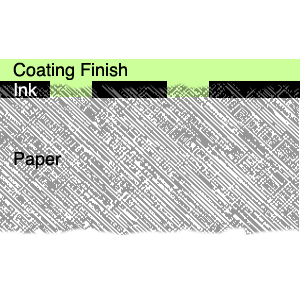 |
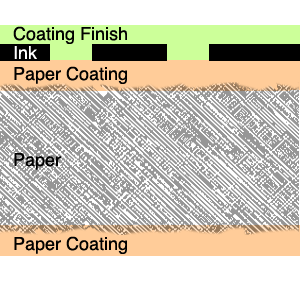 |
|
Exaggerated Side View Illustration
Uncoated paper printed, with coating finish. |
Exaggerated Side View Illustration
Coated paper printed, with coating finish. |
What is aqueous coating?
An aqueous coating is a water-based coating applied to a printed piece to enhance the graphics with a matte or gloss finish and to provide added durability and protection. Aqueous coatings provide good rub and scuff resistance. Like other finishes applied to printed paper, it protects the surface from scratches, fingerprints, dirt, and smudging.
What's the difference between an aqueous coating and traditional varnish?
Aqueous coatings are less costly than varnish. Aqueous coatings are dried in minutes while a traditional varnishes may need a few hours or days to dry. Aqueous coatings don’t yellow with age while varnishes will yellow.
What's the difference between an aqueous coating and UV coating?
Aqueous coatings are dried by hot air, UV coatings are almost instantly dried and cured by ultraviolet light. UV coatings are tougher and more slippery than aqueous. A ballpoint pen can be used to write on an aqueous coating, but not on most UV coatings. UV coatings can achieve a higher gloss.
What is UV coating finishing?
A matte, silk, satin or glossy finish is applied to the entire printed piece. For this type of coating a liquid is applied to the printed paper and exposed to an ultraviolet light which rapidly cures it and bonds it to the paper. UV coating adds durability to the printed piece and deters dirt. For most UV coatings, the piece can no longer be printed on nor written on with a ballpoint pen.
What is spot UV finishing?
A matte, silk, satin or glossy finish can be applied to specific "spot" areas of the printed piece such as photographs and graphic images. For this type of coating a liquid is applied to the printed paper and exposed to an ultraviolet light which rapidly cures it and bonds it to the paper.